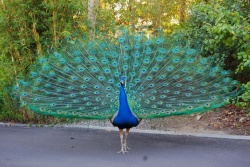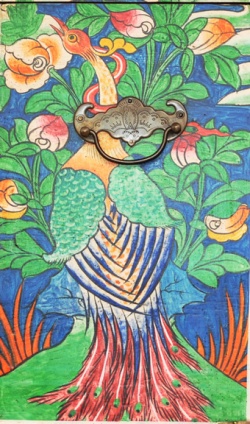Difference between revisions of "Peacock"
| (8 intermediate revisions by 4 users not shown) | |||
| Line 1: | Line 1: | ||
| − | [[File:Peacock.jpg|thumb|250px|]] | + | [[File:Peacock.jpg|thumb|250px|]][[File:peacock4412.jpg|thumb|250px|]] |
| − | + | ||
| − | + | ||
| − | |||
| − | |||
| − | |||
| − | |||
| − | |||
| − | + | In a general [[sense]] [[peacocks]] are a [[Symbol]] of [[openness]] and [[acceptance]]. In {{Wiki|Christianity}} the [[peacock]] is a [[Symbol]] of [[immortality]]. In {{Wiki|Mesopotamia}} appeared a [[symbolic]] [[representation]] of a [[tree]] flanked by two [[peacocks]], which is said to symbolise the [[dualistic]] [[Mind]] and the [[absolute]] {{Wiki|unity}}. In [[Hinduism]] the patterns of the [[peacocks feathers]], resembling [[eyes]], symbolise and {{Wiki|stars}}. In [[Buddhism]] they symbolise [[Wisdom]]. | |
| + | |||
| − | + | [[Peacocks]] are said to have the ability of eating {{Wiki|poisonous}} [[plants]] without being affected by them. Because of that, they are {{Wiki|synonymous}} with the great [[Bodhisattvas]]. A [[Bodhisattva]] is able to take [[delusions]] as the [[path]] toward [[Liberation]] and [[transform]] the {{Wiki|poisonous}} [[Mind]] of [[Ignorance]], [[desire]] and [[hatred]] [ [[moha]], [[raga]], [[dvesa]] ] into the [[Thought]] of [[Enlightenment]] or [[Bodhicitta]], which opens colourfully like the [[peacocks]]' tail. | |
| + | Here we will quote from a [[teaching]] called "The [[wheel of sharp weapons]]", written by [[Dharmaraksita]], who passed it to his main [[Disciple]] [[Dipankara Sri Jnana]] [ [[Atisa]], 982-1054]. | ||
| + | |||
| + | "In jungles of {{Wiki|poisonous}} [[plants]] strut the [[peacocks]], | ||
| + | Through [[medicine]] [[Gardens]] of [[Beauty]] lie near. | ||
| + | The masses of [[peacocks]] do not find [[Gardens]] [[pleasant]], | ||
| + | But thrive on the [[essence]] of {{Wiki|poisonous}} [[plants]], | ||
In similar fashion the brave [[Bodhisattvas]] | In similar fashion the brave [[Bodhisattvas]] | ||
| + | Remain in the jungle of [[worlds]] [[concern]]. | ||
| + | No [[matter]] how [[joyful]] this [[World]] [[pleasure]] [[garden]], | ||
| + | These brave ones are never attracted to [[pleasures]], | ||
| + | But thrive in the jungle of [[Suffering]] and [[pain]]." | ||
| − | |||
| − | + | The [[Mind]] of the [[Sentient beings]] in this [[World]] is like a thick {{Wiki|forest}} of [[desire]] and [[hatred]]. The [[pleasures]] and material {{Wiki|possessions}} are like a beautiful {{Wiki|medicinal}} [[garden]]. The brave-minded [[Bodhisattvas]], because of having realised the shortcomings of [[Samsara]], are not atracted to [[samsaric]] [[pleasures]], just as the [[peacocks]] are not attracted to {{Wiki|medicinal}} [[plants]]. The [[Bodhisattvas]], having the [[attitude]] of wishing only to work for [[Sentient beings]] and not [[desiring]] any [[Happiness]] for themselves, can utilise the {{Wiki|poisonous}} [[thoughts]] of [[Ignorance]], [[desire]], [[hatred]] and so forth in order to accomplish the works for [[Sentient beings]]. | |
| − | + | Bu eating [[poison]], the [[peacocks]]' [[Body]] becomes healthy and beautiful. He is adorned with five feathers on the head, which symbolise the [[Five Paths]] of the [[boddhisattva]] and the [[attainment]] of the [[Five Buddha Families]]. They have beautiful colours, like blue, [[red]], [[green]] and please other [[beings]] just by being seen. Similarly, any [[Body]] who sees a [[Bodhisattva]] receives great [[Happiness]] in his [[Mind]]. The peacock's eating [[habits]] of eating {{Wiki|poisonous}} [[plants]] do not [[cause]] harm to other [[beings]]. Similarly the [[Bodhisattvas]] don not give the slightest harm to any other [[Sentient beings]]. By eating [[poison]] the colours of his feathers become bright and his [[Body]] healthy. Similarly, by taking all problems and [[Suffering]] upon themselves, the [[Bodhisattvas]] quickly {{Wiki|purify}} the [[Mental]] [[obscurations]] and develop their [[Mind]] quickly, [[attaining]] higher and higher [[realization]]. Particularly [[peacocks]] symbolise the transmutting of [[desire]] into the [[path]] of [[Liberation]]. Therefor they are the [[vehicle]] of [[Buddha]] [[Amitabha]], who represents [[desire]] and [[Attachment]] transmuted into the [[Wisdom]] of Discriminating [[Awareness]]. | |
| − | + | {{R}} | |
| − | + | [http://ccbs.ntu.edu.tw/FULLTEXT/JR-BH/bh117490.htm ccbs.ntu.edu.tw] | |
| + | {{NewSourceBreak}} | ||
| + | |||
| + | The [[peacock]] is a very important [[bird]], 1st it is an {{Wiki|emblem}} of romantic [[love]] and [[beauty]]. In [[Buddhism]] the [[peacock]] supports the [[throne]] of [[Amitabha]], the [[red]] [[Buddha]] of the [[west]] (main qualities include [[passion]] ([[lotus]]), [[love]], [[vital]] fluids, evening {{Wiki|twilight}}, summer and [[fire]]). The [[peacock]] is the {{Wiki|mortal}} enemy of {{Wiki|snakes}}, {{Wiki|killing}} cobras with their talons. The main [[quality]] of the [[peacock]] is transmutation of [[poison]] into [[amrita]] or [[nectar]]. This is tied to [[Lord]] [[Shiva]] getting a blue {{Wiki|throat}} from taking the [[poison]] produced by the churning of the ocean; thus the transmutation of [[poison]] or venom by the [[peacock]] | ||
| − | + | is said to produce the electric blue of its {{Wiki|throat}} plumage and the [[wisdom eyes]] of its tail feathers. In [[Vajra]] [[yana]] [[symbolism]] a bundle of [[peacock]] feathers is used as a sprinkler for the [[consecrated]] [[water]] or [[amrita]] contained in the [[blessing]] flask. In specific [[tantric]] [[rituals]] {{Wiki|individual}} feathers are used as fan, [[mirror]], and [[parasol]] adornments, also as the feathers for darts, and as the [[peacock]] feather [[parasol]] used by the [[goddess]] [[Palden Lhamo]], [[symbolizing]] her [[wisdom]] [[activities]] and the transmutation of all [[evils]] or [[poisons]]. | |
| − | + | {{R}} | |
| − | + | [http://www.baronet4tibet.com/symbolism-animals.html baronet4tibet.com] | |
| − | + | [[Category:Peacock]] | |
| − | [[Category: | ||
Latest revision as of 10:39, 6 January 2024
In a general sense peacocks are a Symbol of openness and acceptance. In Christianity the peacock is a Symbol of immortality. In Mesopotamia appeared a symbolic representation of a tree flanked by two peacocks, which is said to symbolise the dualistic Mind and the absolute unity. In Hinduism the patterns of the peacocks feathers, resembling eyes, symbolise and stars. In Buddhism they symbolise Wisdom.
Peacocks are said to have the ability of eating poisonous plants without being affected by them. Because of that, they are synonymous with the great Bodhisattvas. A Bodhisattva is able to take delusions as the path toward Liberation and transform the poisonous Mind of Ignorance, desire and hatred [ moha, raga, dvesa ] into the Thought of Enlightenment or Bodhicitta, which opens colourfully like the peacocks' tail.
Here we will quote from a teaching called "The wheel of sharp weapons", written by Dharmaraksita, who passed it to his main Disciple Dipankara Sri Jnana [ Atisa, 982-1054].
"In jungles of poisonous plants strut the peacocks, Through medicine Gardens of Beauty lie near. The masses of peacocks do not find Gardens pleasant, But thrive on the essence of poisonous plants, In similar fashion the brave Bodhisattvas Remain in the jungle of worlds concern. No matter how joyful this World pleasure garden, These brave ones are never attracted to pleasures, But thrive in the jungle of Suffering and pain."
The Mind of the Sentient beings in this World is like a thick forest of desire and hatred. The pleasures and material possessions are like a beautiful medicinal garden. The brave-minded Bodhisattvas, because of having realised the shortcomings of Samsara, are not atracted to samsaric pleasures, just as the peacocks are not attracted to medicinal plants. The Bodhisattvas, having the attitude of wishing only to work for Sentient beings and not desiring any Happiness for themselves, can utilise the poisonous thoughts of Ignorance, desire, hatred and so forth in order to accomplish the works for Sentient beings.
Bu eating poison, the peacocks' Body becomes healthy and beautiful. He is adorned with five feathers on the head, which symbolise the Five Paths of the boddhisattva and the attainment of the Five Buddha Families. They have beautiful colours, like blue, red, green and please other beings just by being seen. Similarly, any Body who sees a Bodhisattva receives great Happiness in his Mind. The peacock's eating habits of eating poisonous plants do not cause harm to other beings. Similarly the Bodhisattvas don not give the slightest harm to any other Sentient beings. By eating poison the colours of his feathers become bright and his Body healthy. Similarly, by taking all problems and Suffering upon themselves, the Bodhisattvas quickly purify the Mental obscurations and develop their Mind quickly, attaining higher and higher realization. Particularly peacocks symbolise the transmutting of desire into the path of Liberation. Therefor they are the vehicle of Buddha Amitabha, who represents desire and Attachment transmuted into the Wisdom of Discriminating Awareness.
Source
The peacock is a very important bird, 1st it is an emblem of romantic love and beauty. In Buddhism the peacock supports the throne of Amitabha, the red Buddha of the west (main qualities include passion (lotus), love, vital fluids, evening twilight, summer and fire). The peacock is the mortal enemy of snakes, killing cobras with their talons. The main quality of the peacock is transmutation of poison into amrita or nectar. This is tied to Lord Shiva getting a blue throat from taking the poison produced by the churning of the ocean; thus the transmutation of poison or venom by the peacock
is said to produce the electric blue of its throat plumage and the wisdom eyes of its tail feathers. In Vajra yana symbolism a bundle of peacock feathers is used as a sprinkler for the consecrated water or amrita contained in the blessing flask. In specific tantric rituals individual feathers are used as fan, mirror, and parasol adornments, also as the feathers for darts, and as the peacock feather parasol used by the goddess Palden Lhamo, symbolizing her wisdom activities and the transmutation of all evils or poisons.

